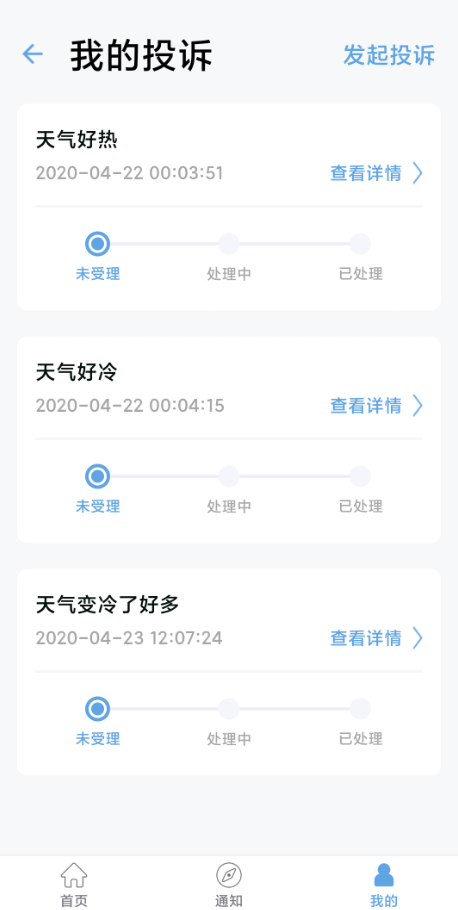这篇文章主要讲解了Android自定义View实现多节点进度条功能的方法,内容清晰明了,对此有兴趣的小伙伴可以学习一下,相信大家阅读完之后会有帮助。
前言
最近项目有一个节点进度条的小需求,完成后,想分享出来希望可以帮到有需要的同学。
真机效果图


自定义View完整代码
开箱即用~,注释已经炒鸡详细了
/**
* @description: 节点进度条
* @author: DMingO
* @date: 2020/4/15
*/
public class PointProcessBar extends View {
/**
* 未选中时的连线画笔
*/
private Paint mLinePaint;
/**
* 选中时的连线画笔
*/
private Paint mLineSelectedPaint;
/**
* 未选中时的文字画笔
*/
private Paint mTextPaint;
/**
* 选中时的文字画笔
*/
private Paint mTextSelPaint;
/**
* 未选中时的实心圆画笔
*/
private Paint mCirclePaint;
/**
* 选中时的内部实心圆画笔
*/
private Paint mCircleSelPaint;
/**
* 选中时的边框圆画笔
*/
private Paint mCircleStrokeSelPaint;
/**
* 未选中时的线,节点圆的颜色
*/
private int mColorUnselected = Color.parseColor("#1ca8b0d9");
/**
* 选中时的颜色
*/
private int mColorSelected = Color.parseColor("#61A4E4");
/**
* 未选中的文字颜色
*/
private int mColorTextUnselected = Color.parseColor("#5c030f09");
/**
* 绘制的节点个数,由底部节点标题数量控制
*/
int circleCount ;
/**
* 连线的高度
*/
float mLineHeight = 7f;
//圆的直径
float mCircleHeight = 50f;
float mCircleSelStroke = 8f;
float mCircleFillRadius = 15f;
//文字大小
float mTextSize = 35f;
//文字离顶部的距离
float mMarginTop = 40f;
/**
* 首个圆向中心偏移的距离
*/
float marginLeft = 30f;
/**
* 最后一个圆向中心偏移的距离
*/
float marginRight = marginLeft;
/**
* 每个节点相隔的距离
*/
float divideWidth;
int defaultHeight;
/**
* 节点底部的文字列表
*/
List<String> textList = new ArrayList<>();
/**
* 文字同宽高的矩形,用来测量文字
*/
List<Rect> mBounds;
/**
* 存储每个圆心在同一直线上的节点圆的 x 坐标值
*/
List<Float> circleLineJunctions = new ArrayList<>();
/**
* 选中项集合
*/
Set<Integer> selectedIndexSet = new HashSet<>();
public PointProcessBar(Context context) {
super(context);
}
public PointProcessBar(Context context, @Nullable AttributeSet attrs) {
super(context, attrs);
initPaint();
}
public PointProcessBar(Context context, @Nullable AttributeSet attrs, int defStyleAttr) {
super(context, attrs, defStyleAttr);
}
public PointProcessBar(Context context, @Nullable AttributeSet attrs, int defStyleAttr, int defStyleRes) {
super(context, attrs, defStyleAttr, defStyleRes);
}
/**
* 初始化画笔属性
*/
private void initPaint(){
mLinePaint = new Paint();
mLineSelectedPaint = new Paint();
mCirclePaint = new Paint();
mTextPaint = new Paint();
mCircleStrokeSelPaint = new Paint();
mTextSelPaint=new Paint();
mCircleSelPaint = new Paint();
mLinePaint.setColor(mColorDef);
//设置填充
mLinePaint.setStyle(Paint.Style.FILL);
//笔宽像素
mLinePaint.setStrokeWidth(mLineHeight);
//锯齿不显示
mLinePaint.setAntiAlias(true);
mLineSelectedPaint.setColor(mColorSelected);
mLineSelectedPaint.setStyle(Paint.Style.FILL);
mLineSelectedPaint.setStrokeWidth(mLineHeight);
mLineSelectedPaint.setAntiAlias(true);
mCirclePaint.setColor(mColorDef);
//设置填充
mCirclePaint.setStyle(Paint.Style.FILL);
//笔宽像素
mCirclePaint.setStrokeWidth(1);
//锯齿不显示
mCirclePaint.setAntiAlias(true);
//选中时外框空心圆圈画笔
mCircleStrokeSelPaint.setColor(mColorSelected);
mCircleStrokeSelPaint.setStyle(Paint.Style.STROKE);
mCircleStrokeSelPaint.setStrokeWidth(mCircleSelStroke);
mCircleStrokeSelPaint.setAntiAlias(true);
//选中时的内部填充圆画笔
mCircleSelPaint.setStyle(Paint.Style.FILL);
mCircleSelPaint.setStrokeWidth(1);
mCircleSelPaint.setAntiAlias(true);
mCircleSelPaint.setColor(mColorSelected);
//普通状态的文本 画笔
mTextPaint.setTextSize(mTextSize);
mTextPaint.setColor(mColorTextDef);
mTextPaint.setAntiAlias(true);
mTextPaint.setTextAlign(Paint.Align.CENTER);
//选中后的文本画笔
mTextSelPaint.setTextSize(mTextSize);
mTextSelPaint.setColor(mColorSelected);
mTextSelPaint.setAntiAlias(true);
mTextSelPaint.setTextAlign(Paint.Align.CENTER);
}
/**
* 测量文字的长宽,将文字视为rect矩形
*/
private void measureText(){
mBounds = new ArrayList<>();
for(String name : textList){
Rect mBound = new Rect();
mTextPaint.getTextBounds(name, 0, name.length(), mBound);
mBounds.add(mBound);
}
}
/**
* 测量view的高度
*/
private void measureHeight(){
if (mBounds!=null && mBounds.size()!=0) {
defaultHeight = (int) (mCircleHeight + mMarginTop + mCircleSelStroke + mBounds.get(0).height()/2);
} else {
defaultHeight = (int) (mCircleHeight + mMarginTop+mCircleSelStroke);
}
}
@Override
protected void onMeasure(int widthMeasureSpec, int heightMeasureSpec) {
int widthSpecMode = MeasureSpec.getMode(widthMeasureSpec);
int widthSpecSize = MeasureSpec.getSize(widthMeasureSpec);
int heightSpecMode = MeasureSpec.getMode(heightMeasureSpec);
int heightSpecSize = MeasureSpec.getSize(heightMeasureSpec);
//宽高都设置为wrap_content
if(widthSpecMode == MeasureSpec.AT_MOST && heightSpecMode == MeasureSpec.AT_MOST){
//宽设置为wrap_content
setMeasuredDimension(widthSpecSize,defaultHeight);
}else if(widthSpecMode == MeasureSpec.AT_MOST){
setMeasuredDimension(widthSpecSize,heightSpecSize);
}else if(heightSpecMode == MeasureSpec.AT_MOST){
//高设置为wrap_content
setMeasuredDimension(widthSpecSize, defaultHeight);
}else{
//宽高都设置为match_parent或具体的dp值
setMeasuredDimension(widthSpecSize, heightSpecSize);
}
}
@Override
protected void onDraw(Canvas canvas) {
//若未设置节点标题或者选中项的列表,则取消绘制
if (textList == null || textList.isEmpty() ||
selectedIndexSet == null || selectedIndexSet.isEmpty() ||
mBounds == null || mBounds.isEmpty()) {
return;
}
//画灰色圆圈的个数
circleCount=textList.size();
//每个圆相隔的距离(重要),可以通过这个调节节点间距
divideWidth = (getWidth() - mCircleHeight ) / (circleCount - 1);
//绘制文字和圆形
for (int i=0; i < circleCount ;i++){
float cx;
float cy;
float textX;
if (i==0){
//第一个节点,圆心需要向右偏移
cx = mCircleHeight / 2 + i * divideWidth + marginLeft;
cy = mCircleHeight / 2 + mCircleSelStroke;
textX = cx;
circleLineJunctions.add(cx + mCircleHeight / 2);
}else if (i==textList.size()-1){
//最后一个节点,圆心需要向左偏移
cx = mCircleHeight / 2 + i * divideWidth - marginRight;
cy = mCircleHeight / 2 + mCircleSelStroke;
textX = cx;
circleLineJunctions.add(cx - mCircleHeight / 2);
}else {
//中间部分的节点
cx = mCircleHeight / 2 + i * divideWidth;
cy = mCircleHeight / 2+mCircleSelStroke;
textX = cx;
circleLineJunctions.add(cx - mCircleHeight / 2);
circleLineJunctions.add(cx + mCircleHeight / 2);
}
if (getSelectedIndexSet().contains(i)){
//若当前位置节点被包含在选中项Set中,判定此节点被选中
canvas.drawCircle(cx , cy, mCircleHeight / 2, mCircleStrokeSelPaint);
canvas.drawCircle(cx, cy, mCircleFillRadius, mCircleSelPaint);
canvas.drawText(textList.get(i), textX, (float) (mCircleHeight + mMarginTop +mCircleSelStroke+mBounds.get(i).height()/2.0), mTextSelPaint);
}else {
//若当前位置节点没有被包含在选中项Set中,判定此节点没有被选中
canvas.drawCircle(cx , cy, mCircleHeight / 2, mCirclePaint);
canvas.drawText(textList.get(i), textX, (float) (mCircleHeight + mMarginTop +mCircleSelStroke+mBounds.get(i).height()/2.0), mTextPaint);
}
}
for(int i = 1 , j = 1 ; j <= circleLineJunctions.size() && ! circleLineJunctions.isEmpty() ; ++i , j=j+2){
if(getSelectedIndexSet().contains(i)){
canvas.drawLine(circleLineJunctions.get(j-1),mCircleHeight/2+mCircleSelStroke,
circleLineJunctions.get(j) ,mCircleHeight/2+mCircleSelStroke,mLineSelectedPaint);
}else {
canvas.drawLine(circleLineJunctions.get(j-1),mCircleHeight/2+mCircleSelStroke,
circleLineJunctions.get(j) ,mCircleHeight/2+mCircleSelStroke,mLinePaint);
}
}
}
/**
* 供外部调用,显示控件
* @param titles 底部标题内容列表
* @param indexSet 选中项Set
*/
public void show(List<String> titles , Set<Integer> indexSet){
if(titles != null && ! titles.isEmpty()){
this.textList = titles;
}
if(indexSet != null && ! indexSet.isEmpty()){
this.selectedIndexSet = indexSet;
}
measureText();
measureHeight();
//绘制
invalidate();
}
/**
* 更新底部节点标题内容
* @param textList 节点标题内容列表
*/
public void refreshTextList(List<String> textList) {
this.textList = textList;
measureText();
measureHeight();
invalidate();
}
/**
* 获取节点选中状态
* @return 节点选中状态列表
*/
public Set<Integer> getSelectedIndexSet() {
return selectedIndexSet;
}
/**
* 更新选中项
* @param set 选中项Set
*/
public void refreshSelectedIndexSet(Set<Integer> set) {
this.selectedIndexSet = set;
invalidate();
}
}注意点
总结
可以看到效果不复杂,因此自定义View的代码行数不多,也很容易看懂,直接拿走代码即可在项目中食用啦。
由于不同项目设计稿会有不同,这里也仅仅给有需要的同学一个思路,可以改造具体实现代码~
看完上述内容,是不是对Android自定义View实现多节点进度条功能的方法有进一步的了解,如果还想学习更多内容,欢迎关注亿速云行业资讯频道。
免责声明:本站发布的内容(图片、视频和文字)以原创、转载和分享为主,文章观点不代表本网站立场,如果涉及侵权请联系站长邮箱:is@yisu.com进行举报,并提供相关证据,一经查实,将立刻删除涉嫌侵权内容。